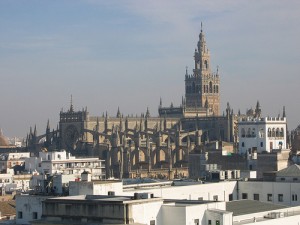
Semana Santa is the signature week of the year in Seville. Hundreds of thousands of people gather to marvel as beautifully ornate golden floats featuring lifelike figures of the soon-to-be-crucified Jesus and his tearful mother are carried head-high along the city’s winding cobbled streets, followed by hundreds of robed and hooded penitents carrying heavy lit candles or heavier wooden crosses. It’s a special kind of open-air theatre, free to view for 10 days straight.
The thing is though, while Semana Santa in Seville is impressive, it’s kinda tiring too. The city’s thronged streets are often impassable, many shops are closed and most bars and restaurants introduce the ‘menu semana santa’ with restricted choice and raised prices. Also, standing around watching hours and hours of broadly-similar processions can get old, especially for those less into the religious angle. Most locals I know find the whole thing tiresome and leave town, unable to stand the crowds, commerciality and chaos.
Luckily then, while these processions, or pasos, only take place at Easter, the spirit of Semana Santa saturates the city all year round. Each barrio’s señor (Jesus) and virgen (Mary) spend their down time on display at home in their own church, while remembrance of holy weeks past and preparations for future pasos never cease. You could argue that the best time to really learn about Seville’s Semana Santa is any of the other 51 weeks of the year.
El Señor del Gran Poder, carved in 1620 by Holy Week master Juan de Mesa, now resides in a purpose-built basilica on Plaza de San Lorenzo. The deep-purple, cloaked, dark wooden figure dominates the building from his post over the altar, with a mix of intense agony and weary acceptance carved deep into his face. Such sublime pain can be difficult for modern non-believers to fathom, but was presumably deeply resonant when the Spanish Inquisition was burning heretics. Steps beside the altar bring you right up close to the Great Power, for female visitors to kiss his shiny wooden heel. A statue of de Mesa himself, coaxing a head and hand from a chunk of wood, stands in the leafy plaza outside.
Macarena’s baroque home
The most beloved Sevillana virgen is Nuestra Señora de la Esperanza Macarena, whose 17th century likeness, attributed to Luisa Roldán, is so hyper-realistically distraught that onlookers at her procession often weep themselves. Seriously. Entering her spectacularly over-the-top baroque home, in the barrio to which she gave her name, your eye is drawn automatically to the blingy gold plinth behind the altar where she stands. You can also step up here to see, but not touch, her hand-spun multi-layered gold and white robe. A carefully-placed mirror offers a close up of her tearful face. Next door, a museum reverently exhibits la Macarena’s golden palo, her penitents’ costumes, crosses, candles, banners, thuribles and croziers, as well as souvenir key-rings, crockery and tee-shirts.
Many more Semana Santa celebrities await veneration around Sevilla’s city centre. The stern El Silencio strides from a quasi-psychedelic wavy silver and gold background in Iglesia San Antonio Abad on Calle Alfonso XII. Nearby, in Iglesia de San Gregorio, El Santo Entierro lies in an opaque glass coffin high above the altar, like the David Blaine of his day.
Iglesia Santa María Magdalena on Calle Bailén has a tableau featuring the recently crucified Jesus being taken down from the cross while his overcome mother and St John look on. Macarena’s rival Nuestra Señora de la Esperanza de Triana is based on Calle Pureza across the river. All these churches are free to enter, but only open a few hours each morning and afternoon before and after services. Most have piped religious music playing to augment the mood.
To get a real feel for Holy Week in Seville however, you must look beyond the churches. Each paso is organised not by priests or nuns, but by brotherhoods (hermandades or cofradías), whose activities are often focused on one neighbourhood bar, usually smallish joints with walls covered in photos of particularly memorable processions and close-ups of virgins in tears. The food and beer is generally cheap and good and visitors, especially those who show a respectful interest, are welcome.
Golden cherubs and Sevillian grandees
In Los Albores, on Calle Palma del Río near La Macarena, you can snack on olives, cheese and vino dulce, while watching VHS tapes of classic Semana Santa years on the bar’s TV. Casa Ricardo, on Calle Hernán Cortéz next to Gran Poder, has walls covered in black-and-white photos of pasos from the 1920s onwards and excellent croquetas de jamón.
Finally, there’s Bar Garlochi on Calle de los Boteros. The bar itself was once a real carved wooden church altarpiece. Naked golden cherubs perch by the liquor bottles. Crimson walls hold photos of long dead Sevillian grandees. Plaster saints teeter in alcoves. A mix-tape of Semana Santa brass and horn marches plays on a loop. Burnished gilded mirrors reflect everything back in a slightly out-of-kilter way. It’s a theme bar, of course, but after knocking back some fierce ‘agua de Sevilla’ (rum, cognac, cava, cointreau and pineapple juice, only served in litre jars for sharing), it’s not uncommon to see some visions – religious or otherwise – of your own.
For me, Garlochi shows the way Sevilla’s Semana Santa, like St Patrick’s Day in Dublin or Pamplona’s San Fermín, fuses religious festival, cultural event and alcohol-fuelled fun. Although based on authentically holy traditions and relics, most visitors now approach it in an ironic and almost, but not quite, sacrilegious way. But unlike Paddy’s Day or Pamplona’s bulls, Holy Week in Seville never stops.
Leave a Reply
You must be logged in to post a comment.